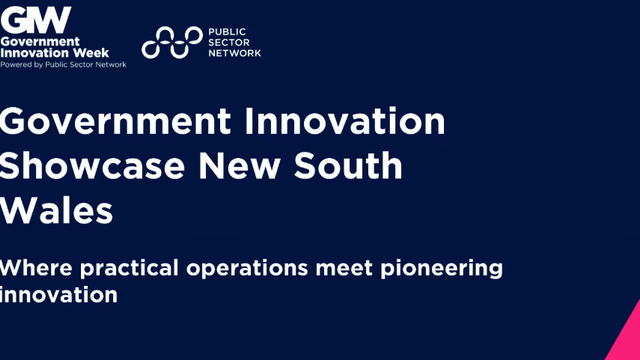Across transport infrastructure, Smart Mobility provides a revolutionary framework for how governments can deliver faster, safer and more efficient commutes within their cities.
In Australia, emerging innovations in mobility technologies are helping to connect communities locally and across regional areas. As an added bonus, these projects are delivering a broad range of social, environmental and economic outcomes, demonstrating the benefits of future mobility in Australia’s states and territories.
Innovative mobility solutions are being implemented across Australian states and territories, with a number of projects currently in-flight across the public sector. Read on to discover
5 innovations transforming Australia’s mobility landscape,
and the broad outcomes being delivered to citizens through more connected, more efficient transport systems.
Intelligent Transport Systems (ITS)
Intelligent Transport Systems (ITS) combine modern computer and communication technologies to transport systems.
By integrating real-time data, communications and vehicle-sensing technologies, ITS can monitor and improve the safety, efficiency, management and operations of vehicles and transport systems. Some of the primary benefits of ITS include improving traffic management, increasing motorway efficiency and the development of smart motorways.
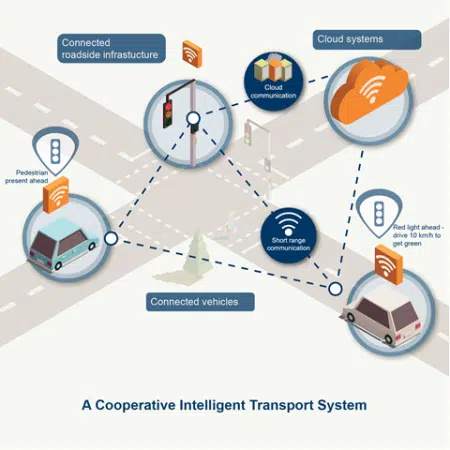
Source:
Queensland Government
Case Study
TfNSW Centre for Road Safety’s Cooperative Intelligent Transport Systems (C-ITS)
Transport for NSW has established Australia’s first testing facility of Cooperative Intelligent Transport Systems – the Cooperative Intelligent Transport Initiative (CITI) Australia, located in the Illawarra region of NSW.
Cooperative Intelligent Transport Systems (C-ITS) allow vehicles to communicate with each other and with infrastructure, such as traffic signals. Vehicles receive alerts about upcoming hazards and traffic signal information, delivering better situational awareness and safety outcomes for drivers.

Source:
Transport for NSW
Connected and Automated Vehicles (CAVs)
Connected and Automated Vehicles (CAVs) refer to various levels of automation in automotive technologies.
CAVs include autonomous (“self driving”) cars, connected cars (such as those in ITS), advanced driver assistance systems (ADAS) and Automated Driving Systems (ADVs). Vehicular automation improves crash elimination, travel time, energy efficiency and beyond, with the various levels of automation scaled through 0-5.
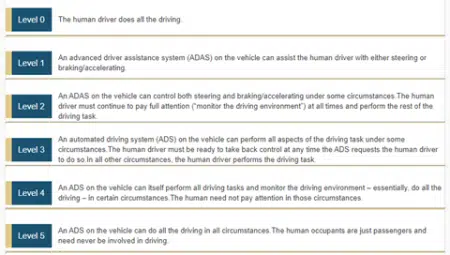
Source: Centre for Advanced Automative Technology (CAAT)
Case Study
Flinders Autonomous Shuttle Trial
In an Australian first, the Department for Infrastructure and Transport has allowed on-road trials of Driverless Vehicles in South Australia. The Department’s Future Mobility Lab continues to lead projects that demonstrate, develop, or contribute to the applied research of Future Mobility technologies.
Most recently, the Department has invested $1 million of Future Mobility Lab Funds into a five-year driverless last mile shuttle project in the Tonsley Innovation District, named FLEX . Initial trials have put driverless shuttles on to public roads within the Tonsley precinct, using a mobile app to allow passengers to book a shuttle between bus stops and their final destination. The vehicle itself is docked within a six-bay solar re-charging garage, available to the public to recharge their electric vehicles for free as part of an awareness campaign to promote carbon neutral transport options.
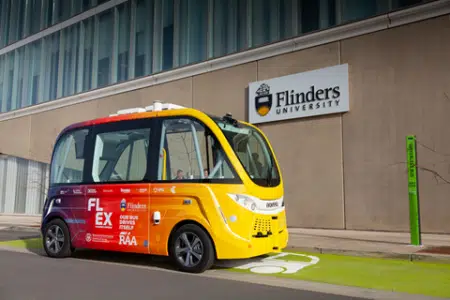
Source: Flinders University
Mobility as a Service (MaaS)
Mobility as a Service (MaaS) is a total mobility solution which focuses on individualising passenger journeys from A to B.
MaaS combines multiple transport modes (such as car and ride share, buses, trains and bike share) to provide flexible and dynamic transport options to citizens. The MaaS landscape integrates dynamic journey planning, booking and payment, often through sleek and user-friendly platforms.
Case Study
Department of Transport and Main Road’s Maas Trial
Public transport services, taxis, rideshare, car share, e-scooters and e-bikes will be involved in a Mobility as a Service (MaaS) trial as part of the DTMR’s involvement in iMove CRC .
Developed in partnership with UQ, the trial will use the ODIN PASS app to provide customers with real-time traffic data and updates about road disruptions, suggest more environmentally friendly routes and allow passengers to plan and book trips.
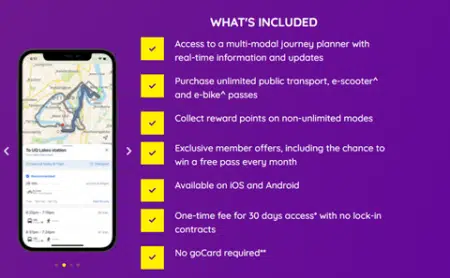
Source: Odin Pass
Smart Ticketing
Smart ticketing makes public transport easier by introducing new ways to plan and pay for your journey.
By introducing ticketing devices that can accept credit or debit cards, smartphones and smart watches (in addition to prepaid travel cards and paper tickets), Smart Ticketing makes public transport functional, accessible and user-friendly for everyone.
Case Study
TransLink’s Smart Ticketing Pilot
Gold Coast light rail commuters have taken to using their American Express and Mastercards, smartphones and smart watches to conveniently pay for adult-fare tram travel under Queensland’s $371 million smart ticketing system .
As a key enabler of the City’s tourism and hospitality industry, this investment in Gold Coast transport infrastructure will support Queensland’s economic recovery . TransLink’s smart ticketing system will also service one of the largest geographical areas of any ticketing system in the world, therefore enabling their infrastructure to scale to future growth and technology.

Source: Queensland Government
Zero Emission Buses (ZEBs)
Zero-emission buses (ZEBs) are an effective and efficient way for communities to reduce their carbon footprint.
ZEB and transit system electrification provide a number of positive outcomes to citizens, helping to combat climate change, improve air quality, and provide a stable infrastructure that is less reliant on fossil fuels and fluctuating energy costs.
Case Study
Transport Canberra ’s first tranche of battery electric buses
The ACT Government has committed to transition their entire bus fleet to zero emissions by 2040 or earlier. As part of their Zero-Emission Transition Plan , thirty-four buses are due to replace the ACT Government’s old Renault diesel buses later this year – many of which will be electric.
Transport Canberra’s Zero-Emission Transition Plan will see every diesel and compressed natural gas bus in the fleet replaced by 2024. The ACT Government intends to permanently procure 90 zero-emissions buses , working with industry to develop transport consortia that provide a holistic solution with supporting infrastructure (charging stations, maintenance, energy supply and so on).
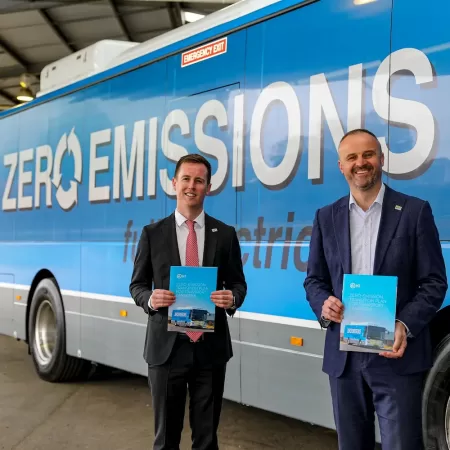
Minister for Transport and City Services Chris Steel (left) said the ACT Government intends to replace every diesel and compressed natural gas bus in Transport Canberra’s fleet with zero-emission buses by 2024.
Source: Facebook
In Summary
Australia’s state and territory transport agencies are making leaps and bounds in the Smart Mobility space, working with industry and academia to provide integrated transport solutions to citizens.
To hear more about current projects and the future of Smart Mobility in Australia, register for Public Sector Network ’s Smart Mobility Virtual Event on Tuesday 21st September 2021. This complimentary online forum will allow transport, freight and mobility professionals working in the public sector to share best practice, benchmark and strategise more efficient and sustainable transport systems for citizens.




